|
The Film

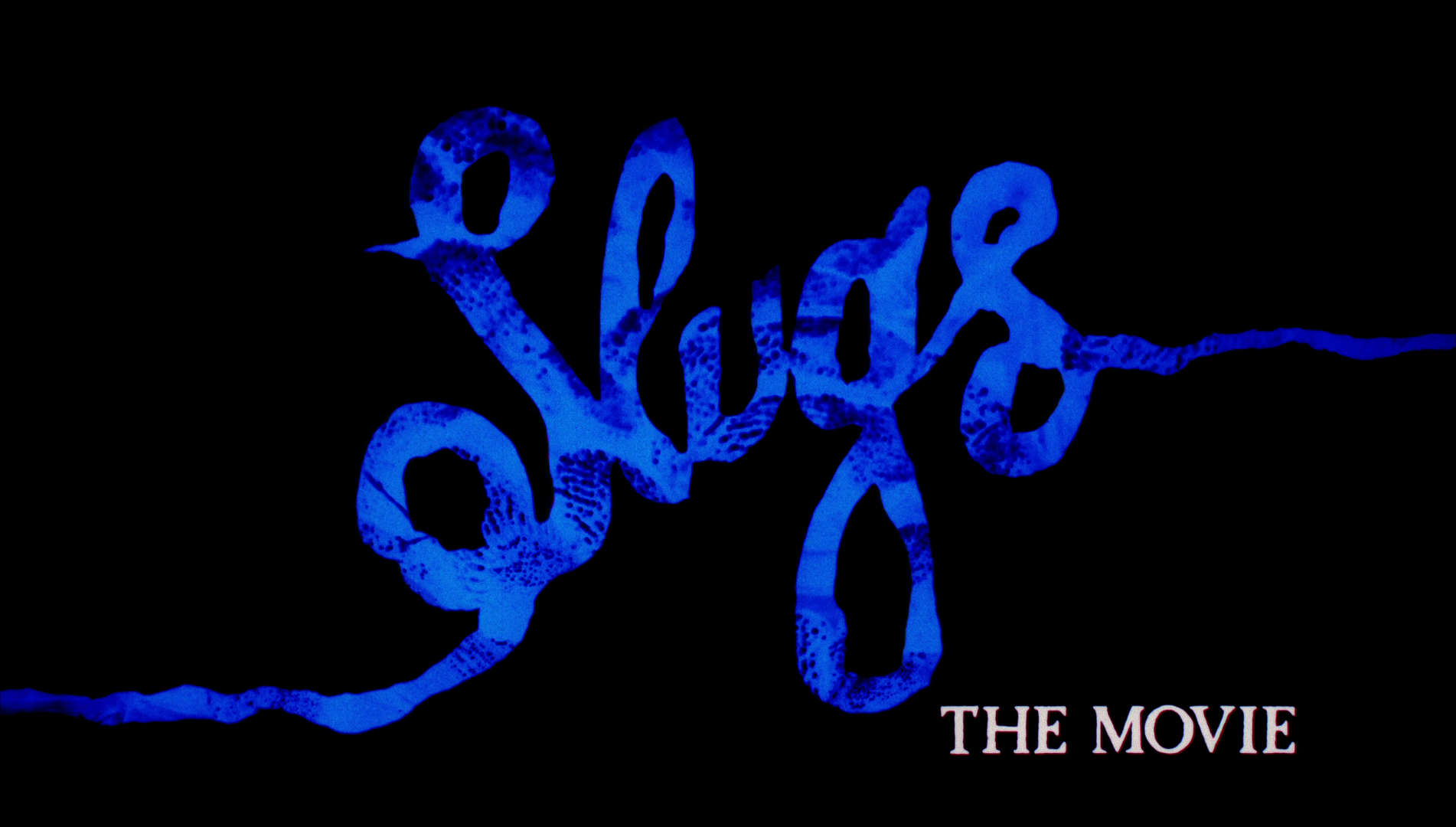 Slugs (J P Simon, 1987) Slugs (J P Simon, 1987)
Directed by Spanish filmmaker Juan Piquer Simon and based on Shaun Hutson’s 1982 novel of the same title, with a genesis like that Slugs (1987) couldn’t be anything other than tacky, tasteless shlock of the highest order – and one of the few films featuring a health inspector as its chief protagonist.
After a young couple fishing in a lake are attacked by an unseen force, and a drunk returning home is devoured in his home by flesh-eating slugs, the small American town of Ashton becomes terrorised by the creatures. Health inspector Mike Brady (Michael Garfield) becomes aware of the slugs after he is bitten by one. He is then faced with the difficult task of convincing the town’s authorities, represented by Sheriff Reese (John Battaglia) and Mayor Eaton (Manuel de Blas), of the problem. Of course, these authority figures find ridiculous the idea that the killer slugs are picking off the town’s inhabitants one-by-one.
After finding a giant slug in his garden, Mike seeks the help of the science teacher at the school where Mike’s wife Kim (Kim Terry) teaches, John (Santiago Alvarez). After studying the slug, which Mike has caught in a jar, John places it with a hamster and watches as the slug attacks and kills the small mammal. Realising the slug is carnivorous, John continues studying the creature. Meanwhile, Mike’s friend, County Sanitation Organiser Don Palmer (Philip MacHale), tells Mike of the ‘half-eaten rats and chickens, and cats, and even a large dog’ that the workers in his department have found in the sewers in recent days. When Mike, Don and John make the realisation that an area just outside the town was used as a landfill site for toxic waste in the 1950s and 1960s, they reach the conclusion that the giant killer slugs were created by this sludge and are breeding in the sewers, coming up through the drains to attack the inhabitants of the town. The trio come up with a plan to rid the town of the slugs once and for all, by venturing into the sewers and dumping a lithium-based compound at the heart of the slugs’ breeding ground.
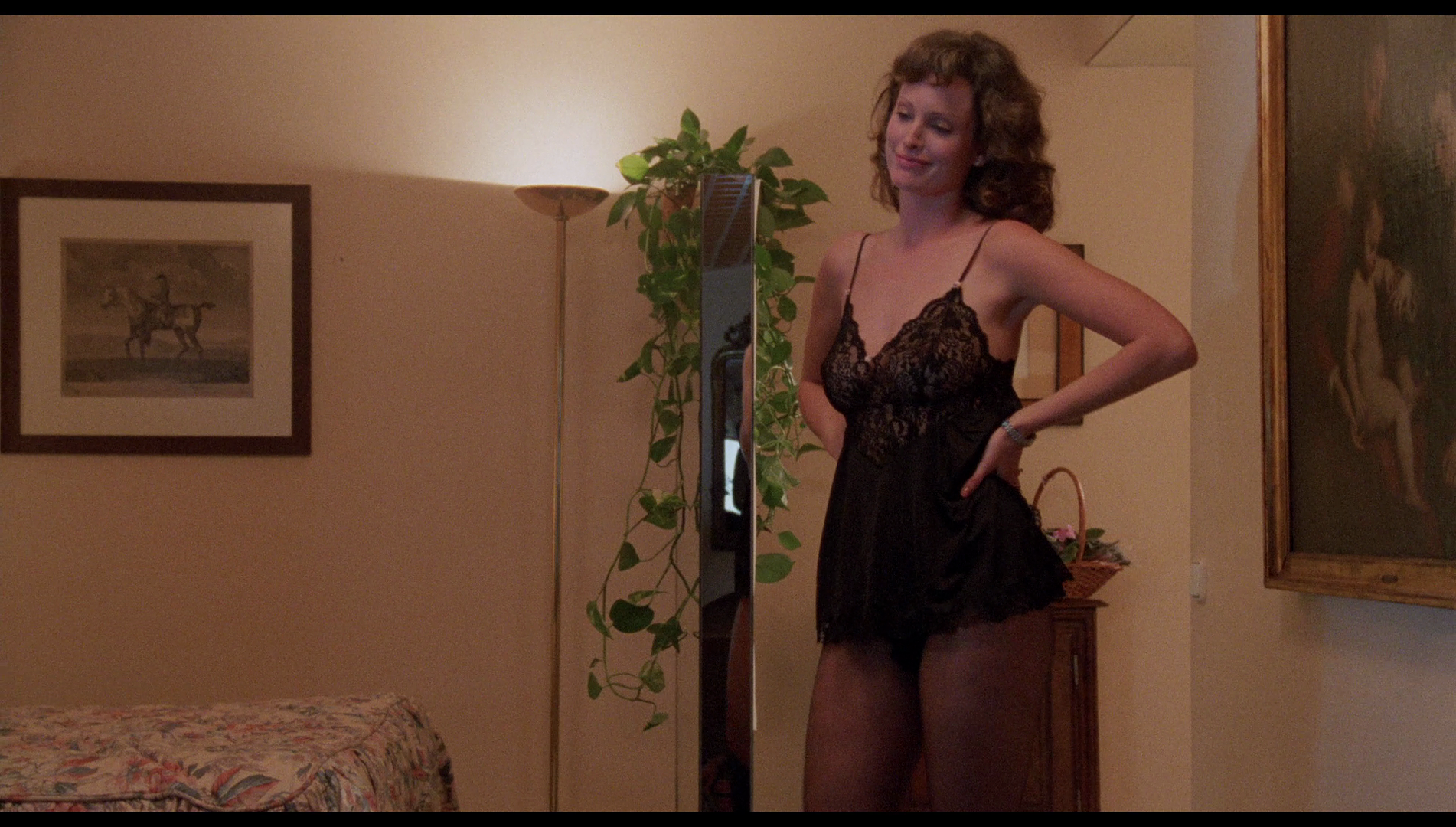 Anyone of a certain age (ie, between 35 and 45) may very well have participated in the circulation of paperback copies of Hutson’s novels in the school playground. It’s nothing to be ashamed of: many of us did it. With their combination of graphic violence and equally lurid sexuality, often combined in a single scenario (the 1988 novel Assassin, for example, featured a resurrected killer who, in one chapter, ejaculates maggots into the mouth of the woman performing fellatio on him), reading Hutson’s novels proved to be a rite of passage for many adolescent fans of horror fiction. Anyone of a certain age (ie, between 35 and 45) may very well have participated in the circulation of paperback copies of Hutson’s novels in the school playground. It’s nothing to be ashamed of: many of us did it. With their combination of graphic violence and equally lurid sexuality, often combined in a single scenario (the 1988 novel Assassin, for example, featured a resurrected killer who, in one chapter, ejaculates maggots into the mouth of the woman performing fellatio on him), reading Hutson’s novels proved to be a rite of passage for many adolescent fans of horror fiction.
Revolving around a species of animal which chooses to rebel en masse against human society, Hutson’s novel Slugs was, like Guy N Smith’s Night of the Crabs (1976), clearly modeled on James Herbert’s trilogy of Rats (1974), Lair (1979) and Domain (1985). (Admittedly, Herbert’s book owes more than a little to Hitchcock’s 1963 film adaptation of Daphne Du Maurier’s novella The Birds.) However, Hutson clearly intended to up the ante in terms of physical revulsion by replacing the already disturbing rats with an even more repulsive species of animal, slugs. (Though admittedly, finding any species repulsive is of course deeply subjective, and I’m sure that some readers of Hutson’s novel were utterly horrified at the author’s attempts to demonise their beloved slugs.) This is underscored in the sequence which takes place after the opening credits of this film adaptation, which features a drunk returning home to a dark house; bills pile up, and so do the slugs. The drunk’s progression through his home is crosscut with close-up shots of a squirming mound of slugs, and from this sequence onwards it's obvious that the film makes much play on the revulsion these animals provoke in many people. The drunk returns to his living room and lays on his sofa before screaming horrendously. Later, we see what has happened to him: the slugs, which were presumably hiding in the sofa, devour him. Aside from the aforementioned influence of The Rats on Hutson's novel, this film adaptation of Slugs also bears comparison with Jeff Lieberman’s memorable flesh-eating worms picture Squirm (1976), with the notion of the slugs breeding in the sewers perhaps owing something to Lewis Teague’s alligator-in-the-sewers film Alligator (1980).
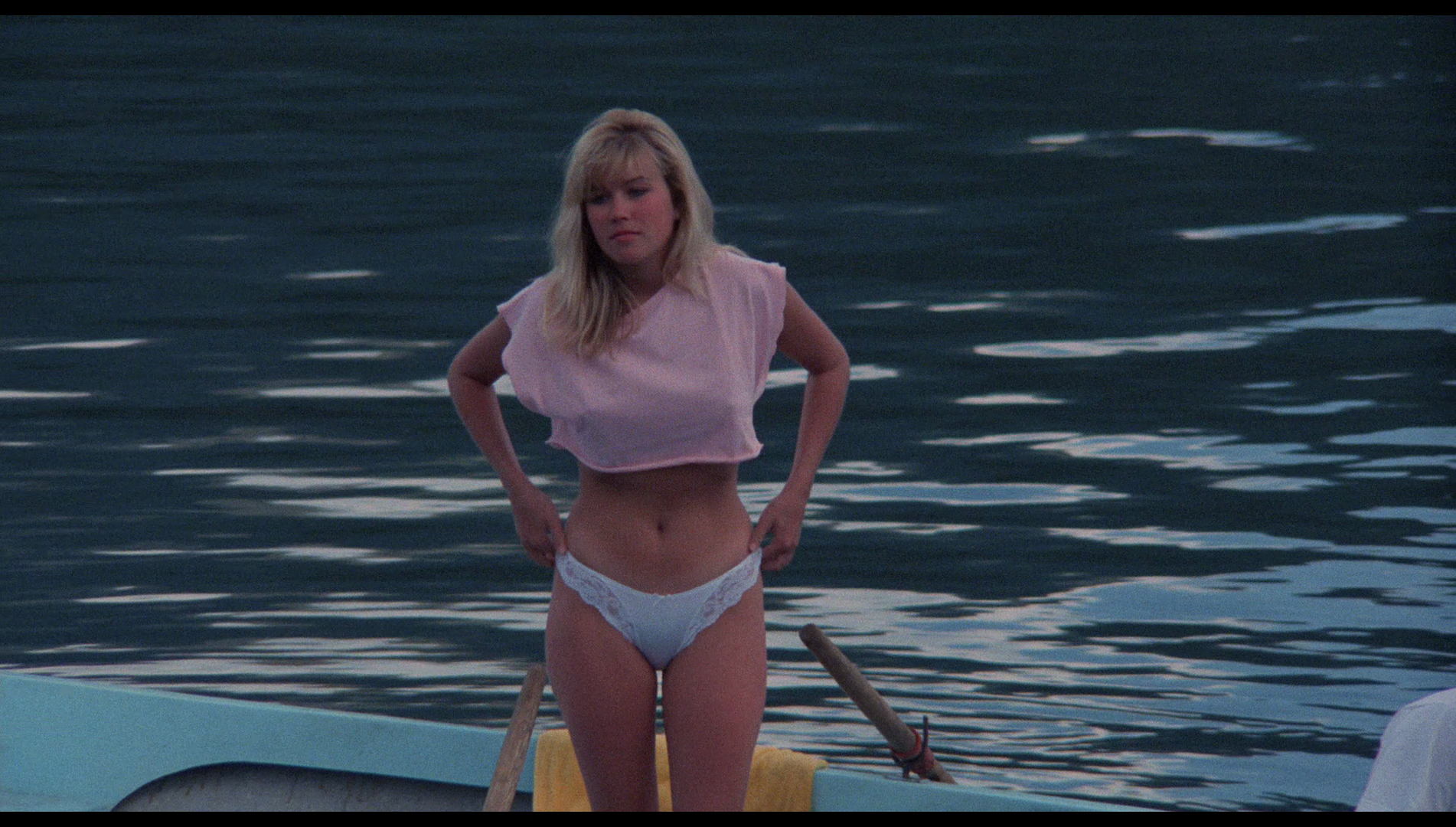 Certainly, both Hutson’s novel and this film adaptation of it came relatively late in the cycle of films (and novels) about nature rebelling against human society that included mainstream favourites (for example, Steven Spielberg’s Jaws, 1975, and Joe Dante’s Piranha, 1978) and more obscure foreign entries - such as Franco Prosperi’s Belvi feroci/Wild Beasts (1984), in which zoo animals run rampant after their water supply is contaminated with PCP, or Rene Cardona Jr’s pastiche of The Birds, El ataque de los pájaros (Beaks/Birds of Prey/Evil Birds, 1987). The first onscreen kill of the titular slugs takes place in the film’s pre-credits sequence, which shows a courting young couple sitting in a small rowboat on a lake near the sewage outlet. The young man is fishing with a rod. (Titter ye not!) He is pulled into the water, and the girl with him panics. A moment passes, in which the viewer might expect the young man to surface and prove to his girlfriend that it was all little more than a bad joke; but then blood bubbles to the surface, and the girl’s screams carry us in to the film’s opening titles. Even the most casual viewer will note the similarities between this opening sequence and the opening sequence of Jaws, in which the shark attacks a young woman who chooses to go skinny dipping during a teen beach party, or the similar opening sequence to Piranha in which a pair of skinny dipping teenagers are pulled under the water at an abandoned swimming pool. Certainly, both Hutson’s novel and this film adaptation of it came relatively late in the cycle of films (and novels) about nature rebelling against human society that included mainstream favourites (for example, Steven Spielberg’s Jaws, 1975, and Joe Dante’s Piranha, 1978) and more obscure foreign entries - such as Franco Prosperi’s Belvi feroci/Wild Beasts (1984), in which zoo animals run rampant after their water supply is contaminated with PCP, or Rene Cardona Jr’s pastiche of The Birds, El ataque de los pájaros (Beaks/Birds of Prey/Evil Birds, 1987). The first onscreen kill of the titular slugs takes place in the film’s pre-credits sequence, which shows a courting young couple sitting in a small rowboat on a lake near the sewage outlet. The young man is fishing with a rod. (Titter ye not!) He is pulled into the water, and the girl with him panics. A moment passes, in which the viewer might expect the young man to surface and prove to his girlfriend that it was all little more than a bad joke; but then blood bubbles to the surface, and the girl’s screams carry us in to the film’s opening titles. Even the most casual viewer will note the similarities between this opening sequence and the opening sequence of Jaws, in which the shark attacks a young woman who chooses to go skinny dipping during a teen beach party, or the similar opening sequence to Piranha in which a pair of skinny dipping teenagers are pulled under the water at an abandoned swimming pool.
In terms of its suggestion that the mutant man-eating slugs were caused by the dumping of toxic waste, Slugs feels very much of its time, sitting alongside other nightmarish pictures about the disposal of toxic waste such as The Return of the Living Dead (Dan O’Bannon, 1984, in which toxic waste causes zombies), Choke Canyon (Charles Ball, 1986, in which an unconventional scientist attempts to stop a corporation dumping illegal toxic waste), RoboCop (Paul Verhoeven, 1987, in which a member of Clarence Boddicker’s gang, Emil Antonowsky, is dissolved by toxic waste after crashing his stolen car into a crate of the stuff), and The Toxic Avenger (Lloyd Kaufman & Michael Herz, 1984, in which nerd Melvin Junko falls into toxic waste and becomes the world’s first superhero from New Jersey).
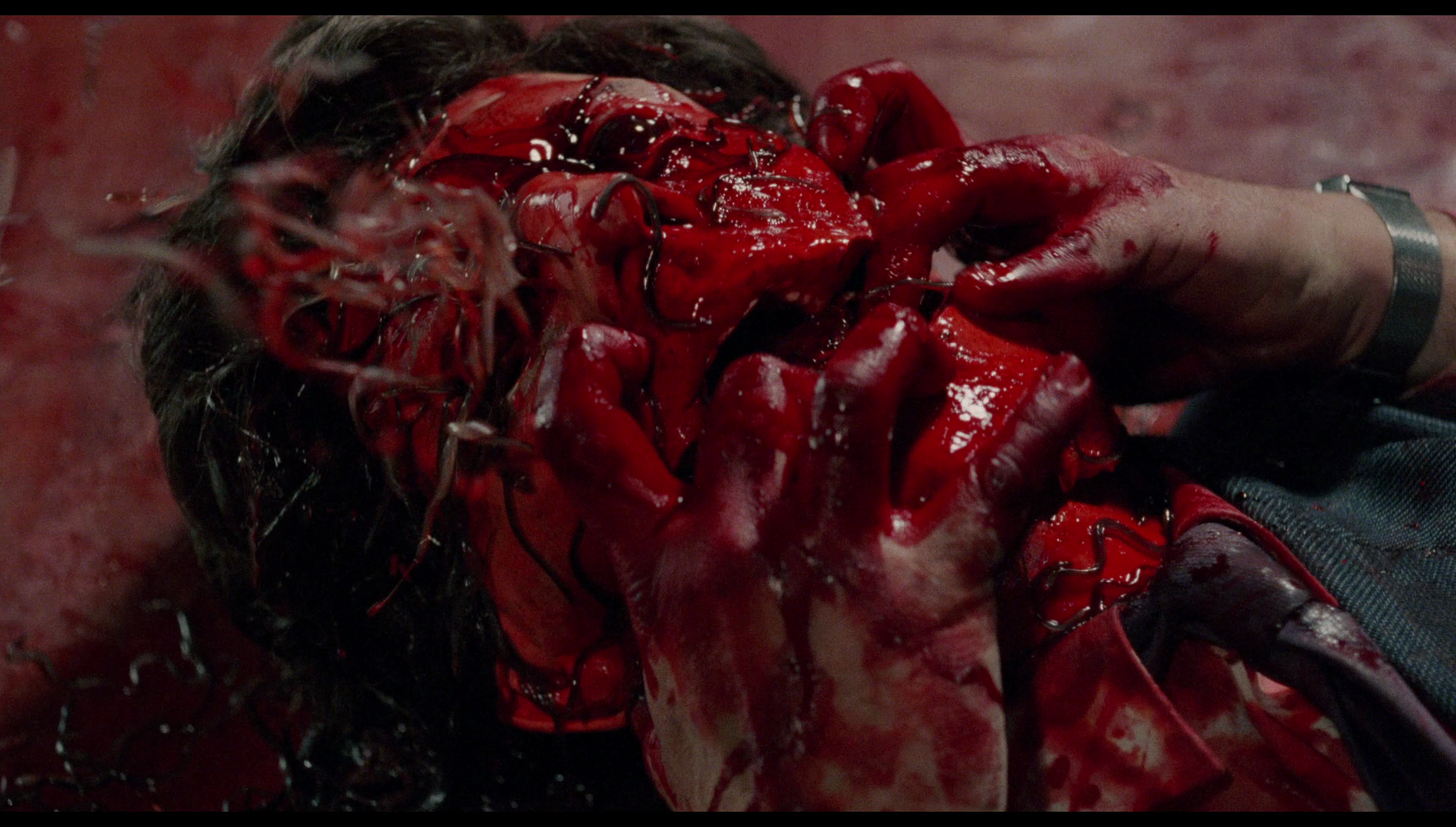 The film foregrounds its small town setting, David Watson’s wife Maureen (Alicia Moro) referring to the town as ‘the armpit of America and the centre of boredom for the entire planet Earth’. The slugs represent a disruption to the boredom associated with this small town, much like the shark represents a disruption to the equilibrium experienced on Amity Island in Jaws. The devastation left in the wake of the titular slugs is inconceivable to the populace. When the drunk’s corpse is discovered, his face degloved and the flesh apparently eaten by the creatures, a police officer at the scene asserts ‘I saw nothing like it before. Not even in ’Nam. Something ate the sucker’s eyes right out!’ Sheriff Reese guesses, correctly, that the drunk’s injuries were caused by an animal, though Reese leaves killer, flesh-eating slugs off his list of possible suspects: ‘Wild dogs, maybe’, he suggests, ‘Raccoons driven out of the hills by the cold’. Mike’s guess, at this stage of the narrative, hints at the James Herbert book that inspired Hutson’s novel: ‘Rats, maybe?’, Mike queries. The film foregrounds its small town setting, David Watson’s wife Maureen (Alicia Moro) referring to the town as ‘the armpit of America and the centre of boredom for the entire planet Earth’. The slugs represent a disruption to the boredom associated with this small town, much like the shark represents a disruption to the equilibrium experienced on Amity Island in Jaws. The devastation left in the wake of the titular slugs is inconceivable to the populace. When the drunk’s corpse is discovered, his face degloved and the flesh apparently eaten by the creatures, a police officer at the scene asserts ‘I saw nothing like it before. Not even in ’Nam. Something ate the sucker’s eyes right out!’ Sheriff Reese guesses, correctly, that the drunk’s injuries were caused by an animal, though Reese leaves killer, flesh-eating slugs off his list of possible suspects: ‘Wild dogs, maybe’, he suggests, ‘Raccoons driven out of the hills by the cold’. Mike’s guess, at this stage of the narrative, hints at the James Herbert book that inspired Hutson’s novel: ‘Rats, maybe?’, Mike queries.
The film moves swiftly, from setpiece to setpiece with often only the barest thread of narrative to link them. At several points, the film crosscuts the events leading up to the deaths of several victims of the slugs. Almost all of these attacks take place, or at the very least begin, in the victims’ homes, with the slugs intruding on the domestic space. (Interestingly, in the case of many of the victims – including the drunk who is attacked by the slugs whilst laying on his sofa – their domestic lives are represented as less than ideal. These victims’ unpleasant home lives are contrasted with the apparently happy marriages of both Mike and Don.) In one sequence, Maureen, who has been introduced as something of a lush, is shown preparing for the arrival of her husband David. She dumps a lettuce in the sink whilst getting down to the serious business of boozing it up until David gets home. When David finally returns home, he eats the salad Maureen has not-so-painstakingly prepared for him, unaware that in the lettuce the slugs – which have slithered up the drain – have left the eggs of their own parasitic worms. During the evening, David complains of pains in his stomach and, later, head. However, he refuses to cancel a meeting with an important client; during his meeting with this client at a restaurant the next day, David begins convulsing in agony before suffering a sudden nosebleed. Finally, blood erupts from his face and worms explode from his eye sockets: the eggs of the parasites he has unwittingly devoured have hatched within his body and entered his bloodstream, the worms in effect eating David from the inside out.
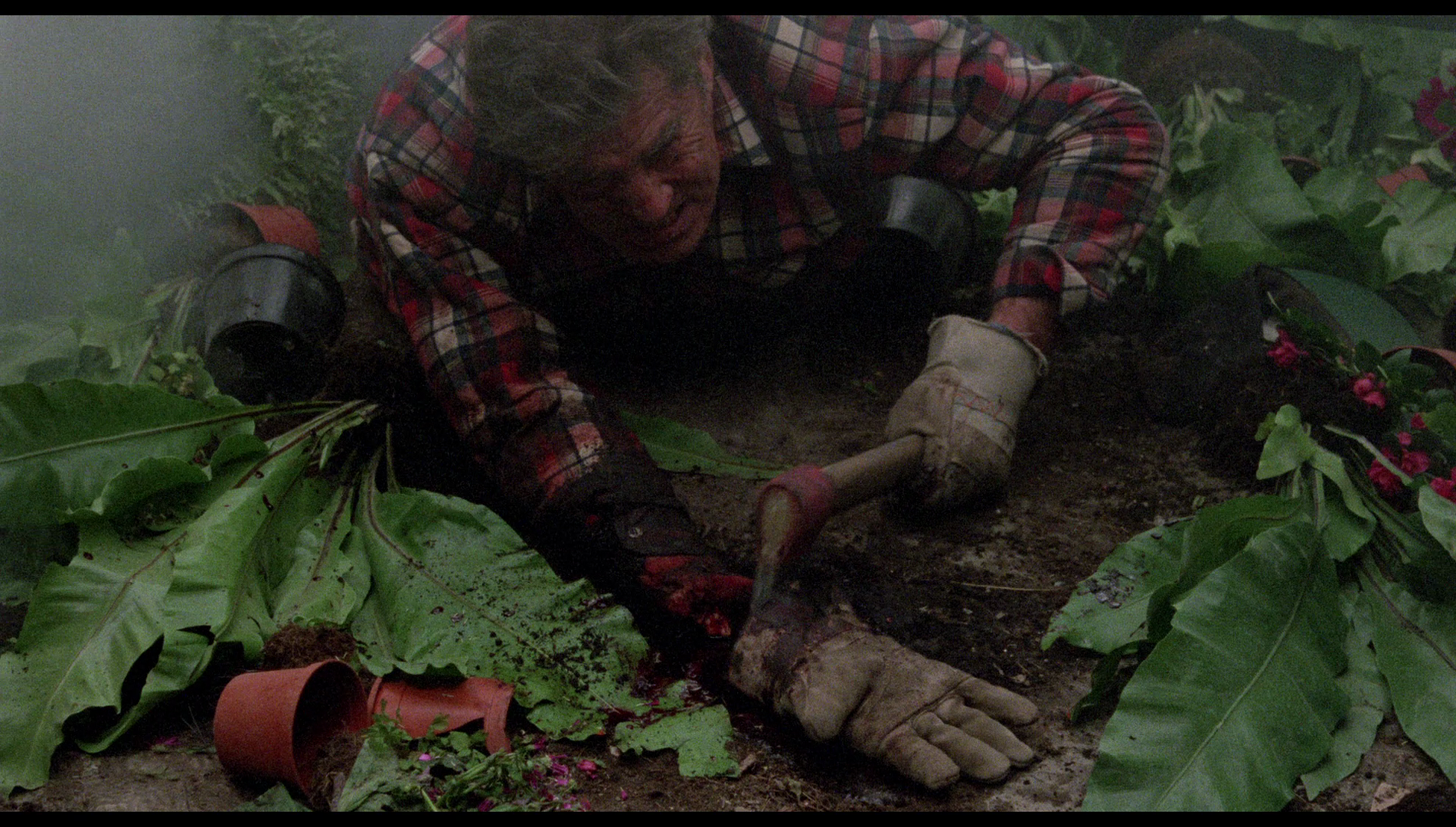 David’s fate is crosscut with that of keen gardener Harold Morris (Juan Majan) and his wife Jean (Lucia Prado), who likewise are attacked in their home by the slugs. This scene begins with Harold and Jean squabbling over the state of the large greenhouse that is attached to the side of their house. When Jean leaves the greenhouse, Harold continues with his labours, chuntering to himself: ‘Never leave you alone. Women. Gets more like her mother every day’. He puts on a gardening glove. However, a slug inside it bites his hand and won’t let Harold remove the glove. Harold tries desperately to get the glove off, flailing about and smashing the pots in the greenhouse, spilling caustic chemicals on the floor. Desperate, he takes the (bizarre) decision to hack his own hand off at the wrist with a hand-axe. Meanwhile, his wife Jean is oblivious to the peril Harold is in: she is listening to loud music whilst operating the vacuum cleaner in the hallway. Finally, Jean ceases her music and enters the greenhouse, finding her husband on the floor, hacking desperately at his arm with the axe as the chemicals spilt on the floor of the greenhouse ignite and blow the building to bits. David’s fate is crosscut with that of keen gardener Harold Morris (Juan Majan) and his wife Jean (Lucia Prado), who likewise are attacked in their home by the slugs. This scene begins with Harold and Jean squabbling over the state of the large greenhouse that is attached to the side of their house. When Jean leaves the greenhouse, Harold continues with his labours, chuntering to himself: ‘Never leave you alone. Women. Gets more like her mother every day’. He puts on a gardening glove. However, a slug inside it bites his hand and won’t let Harold remove the glove. Harold tries desperately to get the glove off, flailing about and smashing the pots in the greenhouse, spilling caustic chemicals on the floor. Desperate, he takes the (bizarre) decision to hack his own hand off at the wrist with a hand-axe. Meanwhile, his wife Jean is oblivious to the peril Harold is in: she is listening to loud music whilst operating the vacuum cleaner in the hallway. Finally, Jean ceases her music and enters the greenhouse, finding her husband on the floor, hacking desperately at his arm with the axe as the chemicals spilt on the floor of the greenhouse ignite and blow the building to bits.
‘Jesus!’, Mike declares when Kim tells him of Jean and Harold’s deaths, ‘They were nice people. I liked them a lot’. In contrast with these other couples, when they encounter the slugs Mike and Kim co-operate. ‘I saw the biggest slug in the world right before you got here’, Kim tells Mike. ‘Jesus!’, Mike exclaims when he sees one of the slugs in the garden, ‘Those things are gigantic!’ When Mike reaches out to the slug, it bites his finger. ‘What kind of slug bites someone?’, Kim asks aloud. ‘I don’t know but he’s living in our garden’, Mike exclaims.
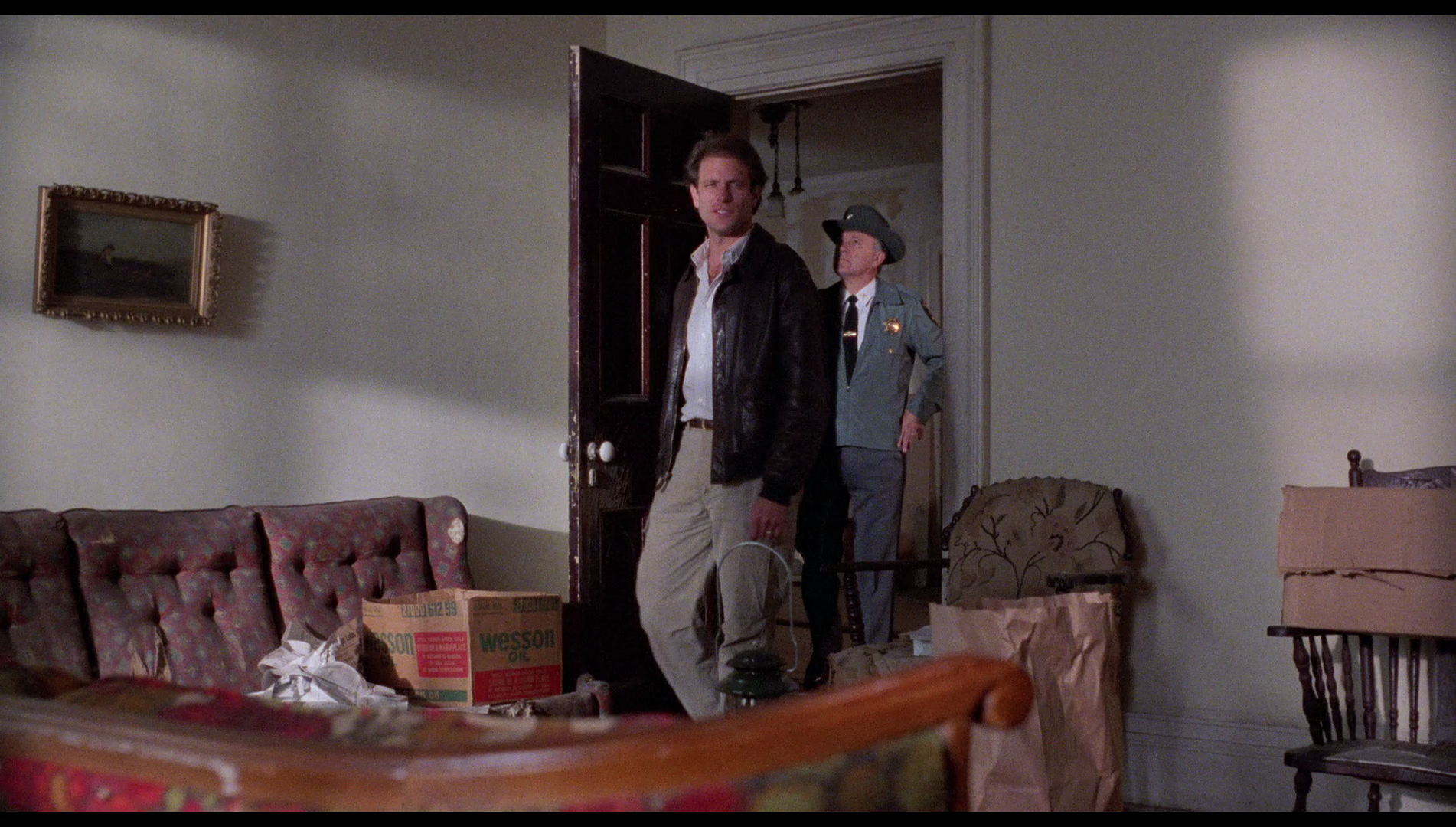 Mike’s attempts to persuade the authorities of the reality of the situation are blackly comical and seem deliberately reminiscent of Police Chief Brody’s (Roy Scheider) attempts to persuade the Mayor of Amity Island (Murray Hamilton) that the community must deal with a killer Great White shark during the prosperous Fourth of July weekend in Jaws. ‘Maybe, just maybe we’re dealing with a mutated form of slug here’, Mike tells Sheriff Reese after the bodies of Donna and Bobby are found, ‘one that eats meat’. Reese laughs scornfully at this idea. ‘Killer slugs!’, he says, ‘What’ll it be next? Demented crickets? Rampaging mosquitoes, maybe?’ (Reese has clearly not watched any of the killer animal pictures from the 1970s and early 1980s – films like Belvi feroci or Saul Bass’ 1974 killer ant picture Phase IV, for example.) ‘So you explain the slimy shit on the floor and the dead bodies’, Mike asserts angrily. When Mike takes his crusade to the head of the water department, Frank Philips (Frank Brana), he is told unceremoniously that ‘You’re nuts [….] You ain’t got the authority to declare “happy birthday” – not in this town’. Ironic justice is served when Philips decides to use the private toilet that adjoins his office and is attacked and killed there by slugs coming out of the cistern, only for his body to be found in such a humiliating scenario by his secretary when she returns from her lunch break. Mike’s attempts to persuade the authorities of the reality of the situation are blackly comical and seem deliberately reminiscent of Police Chief Brody’s (Roy Scheider) attempts to persuade the Mayor of Amity Island (Murray Hamilton) that the community must deal with a killer Great White shark during the prosperous Fourth of July weekend in Jaws. ‘Maybe, just maybe we’re dealing with a mutated form of slug here’, Mike tells Sheriff Reese after the bodies of Donna and Bobby are found, ‘one that eats meat’. Reese laughs scornfully at this idea. ‘Killer slugs!’, he says, ‘What’ll it be next? Demented crickets? Rampaging mosquitoes, maybe?’ (Reese has clearly not watched any of the killer animal pictures from the 1970s and early 1980s – films like Belvi feroci or Saul Bass’ 1974 killer ant picture Phase IV, for example.) ‘So you explain the slimy shit on the floor and the dead bodies’, Mike asserts angrily. When Mike takes his crusade to the head of the water department, Frank Philips (Frank Brana), he is told unceremoniously that ‘You’re nuts [….] You ain’t got the authority to declare “happy birthday” – not in this town’. Ironic justice is served when Philips decides to use the private toilet that adjoins his office and is attacked and killed there by slugs coming out of the cistern, only for his body to be found in such a humiliating scenario by his secretary when she returns from her lunch break.
There are some oddball moments, such as when the teachers at Kim’s school walk along a corridor in the school itself and talk loudly and openly about the discovery of the drunk’s corpse within earshot of the schoolchildren. Another sequence seems placed in the film simply to add some nudity to the gore: in a nightmarish sequence, a young couple, Bobby (Kris Mann) and Donna (Kari Rose), fuck vigorously in the young woman’s house whilst her parents are out. Post-coitus, a naked Donna steps out of the bed but finds the floor carpeted with the killer slugs. She slips on them and falls to the floor. They eat her alive as she reaches out to Bobby for help. Unable to assist Donna, Bobby attempts to climb out of the window but similarly falls and is eaten by the slugs. It’s a gruesome sequence, combining sex, nudity and gore in a potent mix – and consequently, it is easily the film’s most haunting moment. Later, the film’s approach to sexual politics is foregrounded when, during an outdoor party held by the teenage pupils of the local school, one of the students, Pam (Tammy Reger), is assaulted sexually by her overeager boyfriend. Pam manages to escape from his grasp and flees, falling into the open sewer where she is attacked and eaten by the slugs residing there, almost as a 'punishment' for her rebuttal of her boyfriend.
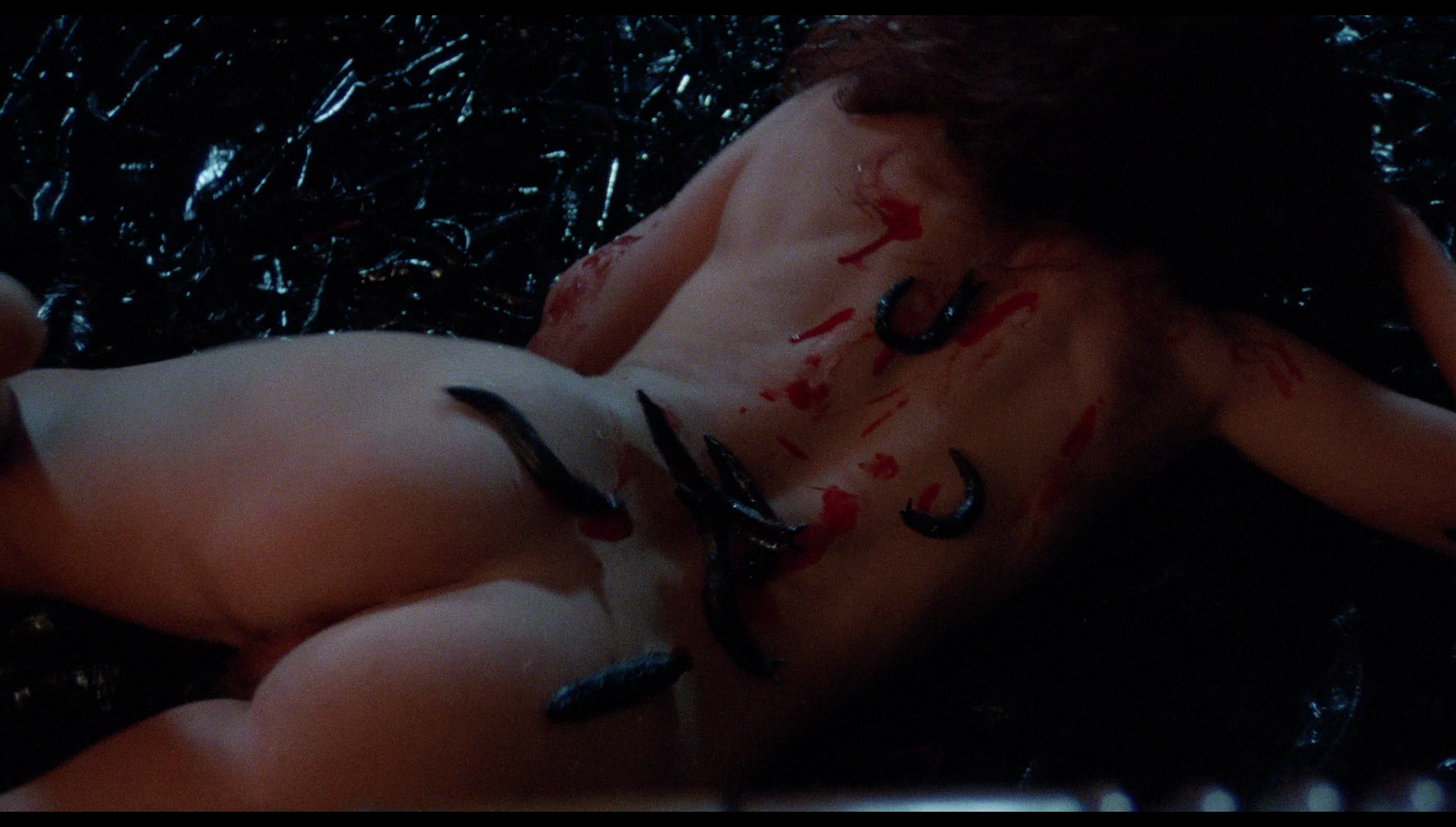 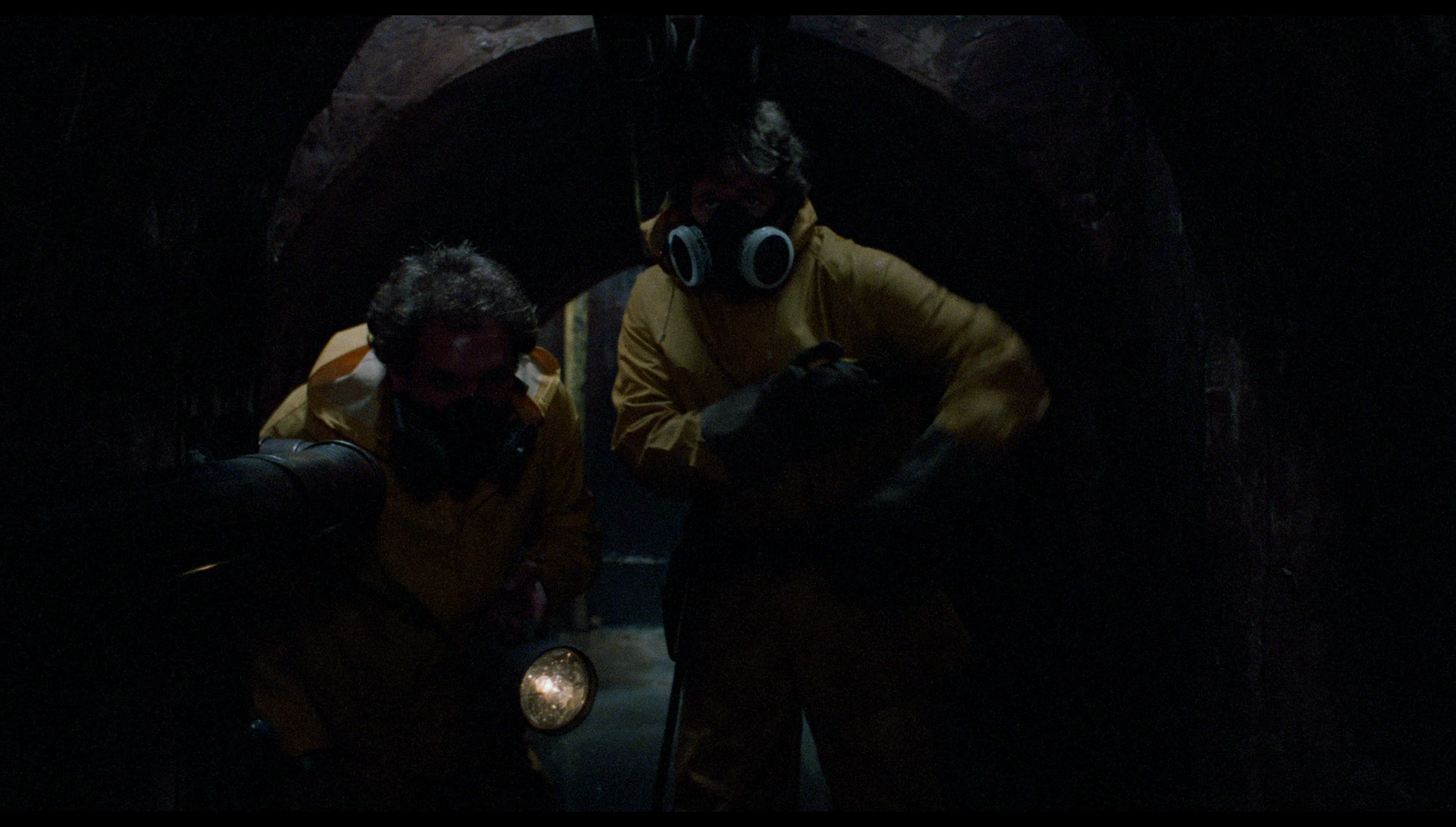 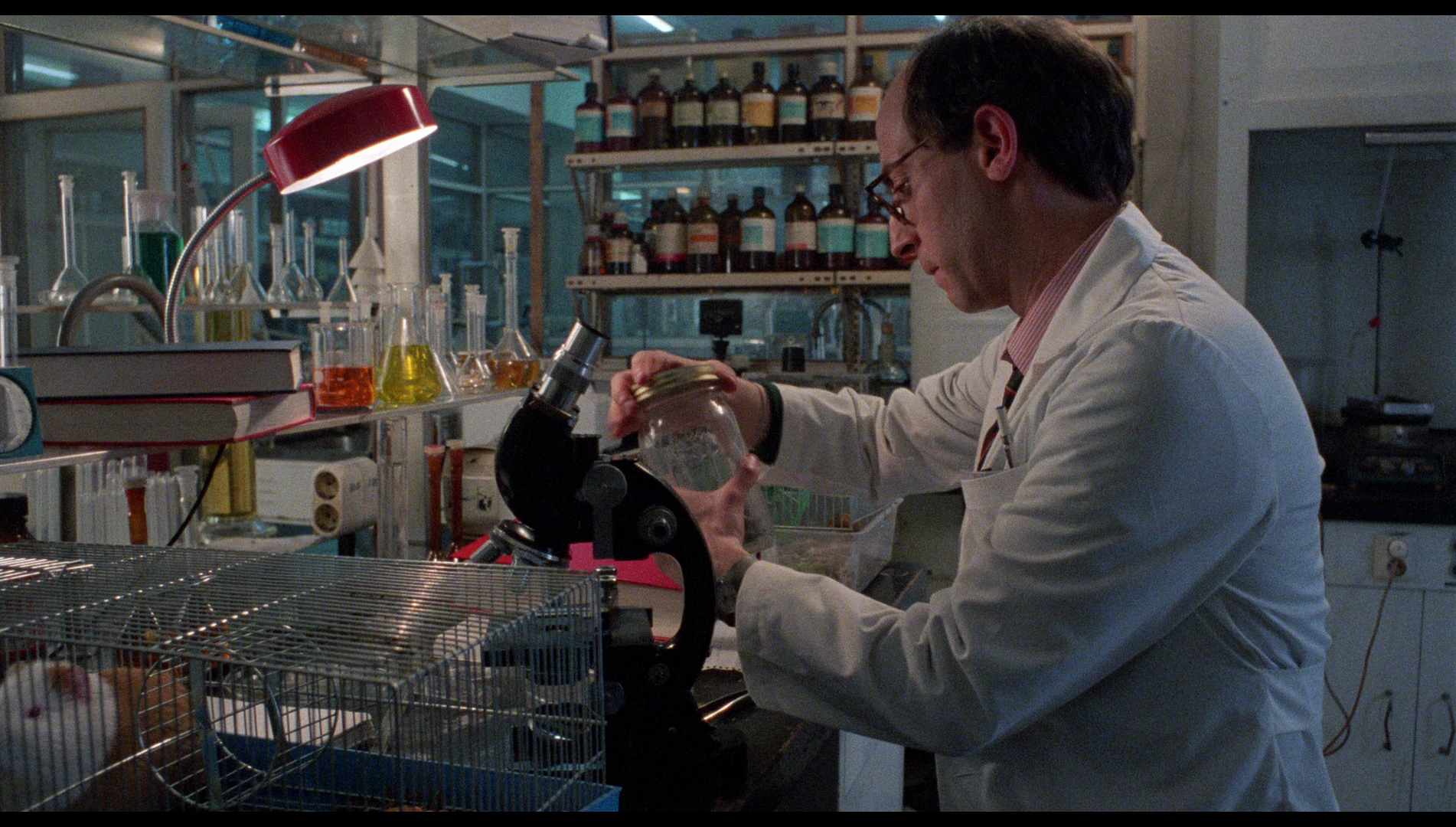
Video
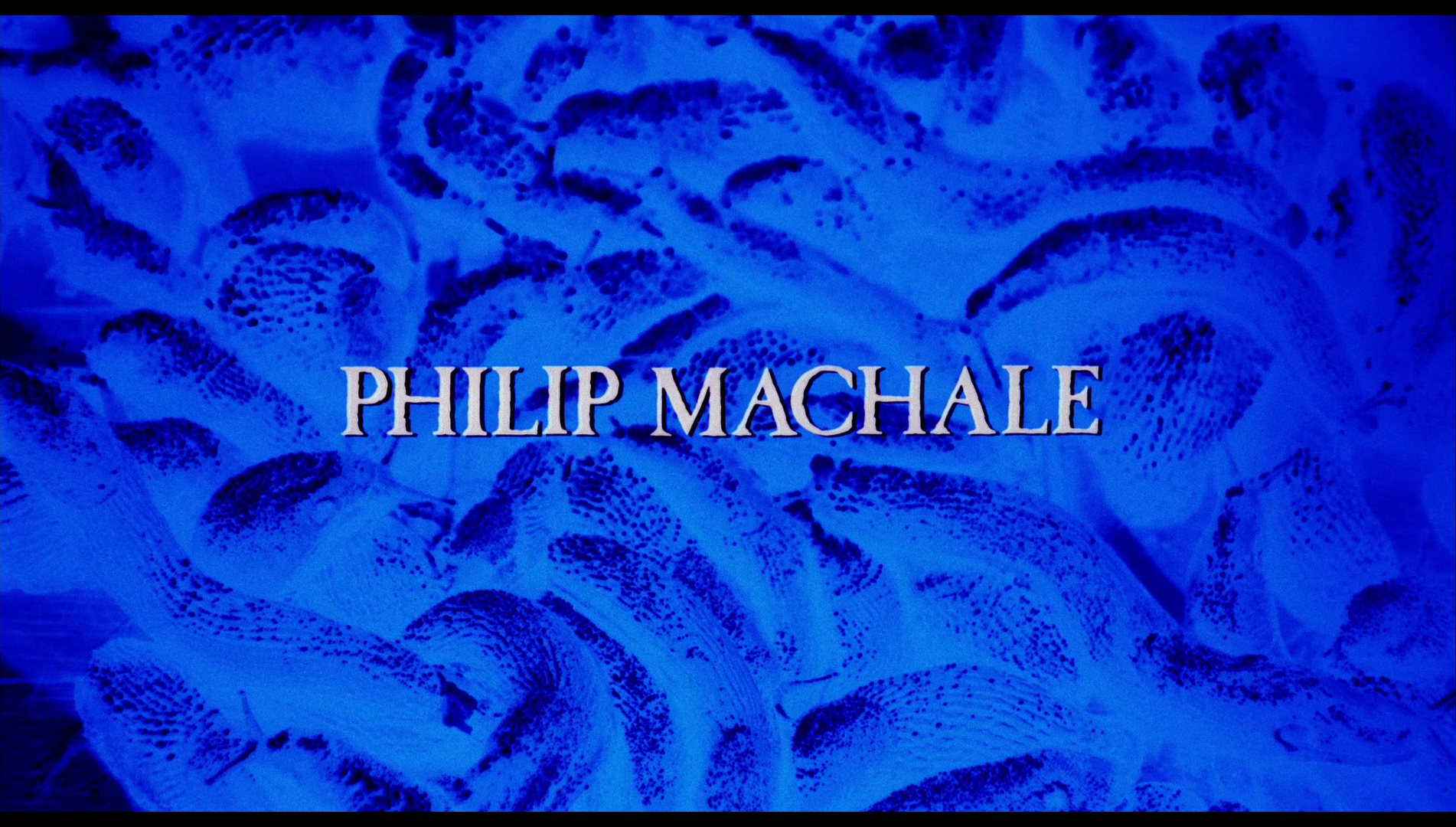 The presentation is in 1080p and uses the AVC codec. Presented in its original aspect ratio of 1.85:1, Slugs is here uncut, with a running time of 89:15 mins. When submitted to the BBFC for video classification in 1989, the BBFC demanded 42s of cuts to the picture which persisted in subsequent home video releases until the film’s 2009 DVD release – at which point the BBFC waived the cuts they had previously imposed on the film. (The old UK VHS release trimmed the scene in which Harold cuts off his own hand with the hand axe, the shot of the slug killing the hamster in John’s lab at the school, and made substantial trims to the sequence in which the naked Donna is eaten alive by the slugs in front of her horrified and helpless boyfriend Bobby.) The presentation is in 1080p and uses the AVC codec. Presented in its original aspect ratio of 1.85:1, Slugs is here uncut, with a running time of 89:15 mins. When submitted to the BBFC for video classification in 1989, the BBFC demanded 42s of cuts to the picture which persisted in subsequent home video releases until the film’s 2009 DVD release – at which point the BBFC waived the cuts they had previously imposed on the film. (The old UK VHS release trimmed the scene in which Harold cuts off his own hand with the hand axe, the shot of the slug killing the hamster in John’s lab at the school, and made substantial trims to the sequence in which the naked Donna is eaten alive by the slugs in front of her horrified and helpless boyfriend Bobby.)
Colour reproduction in the presentation of the film contained on Arrow’s Blu-ray is very impressive, and this is noticeable from the opening scene in which the young man falls off the boat and into the water, crimson blood gushing to the surface; it’s also noticeable in the opening titles sequence, which features the credits playing over a blue-tinted negative image of a mass of slugs crawling over one another. Contrast is very good, and another area of immediately noticeable improvement over the film’s previous home video releases: the many night-time scenes, not to mention the climax in which Mike and Don venture into the dark sewers to clear out the slugs’ breeding ground, are now visible and contain depth and detail whilst also retaining rich, deep shadows. Detail throughout the film is very pleasing, and there’s little to no evidence of damage. Finally, a strong encode ensures that the presentation retains the structure of 35mm film, resulting in an organic, filmlike appearance to the movie.
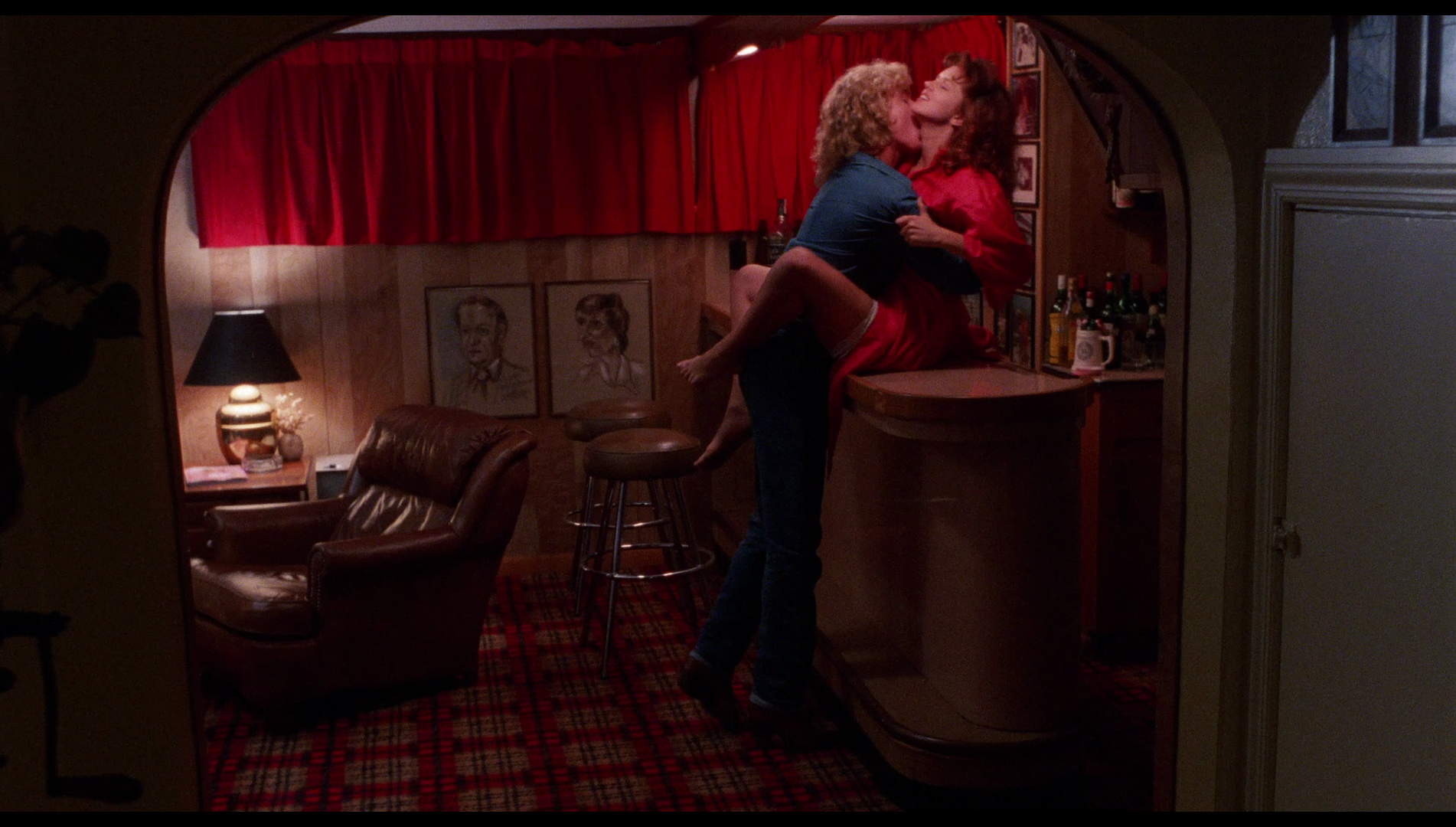 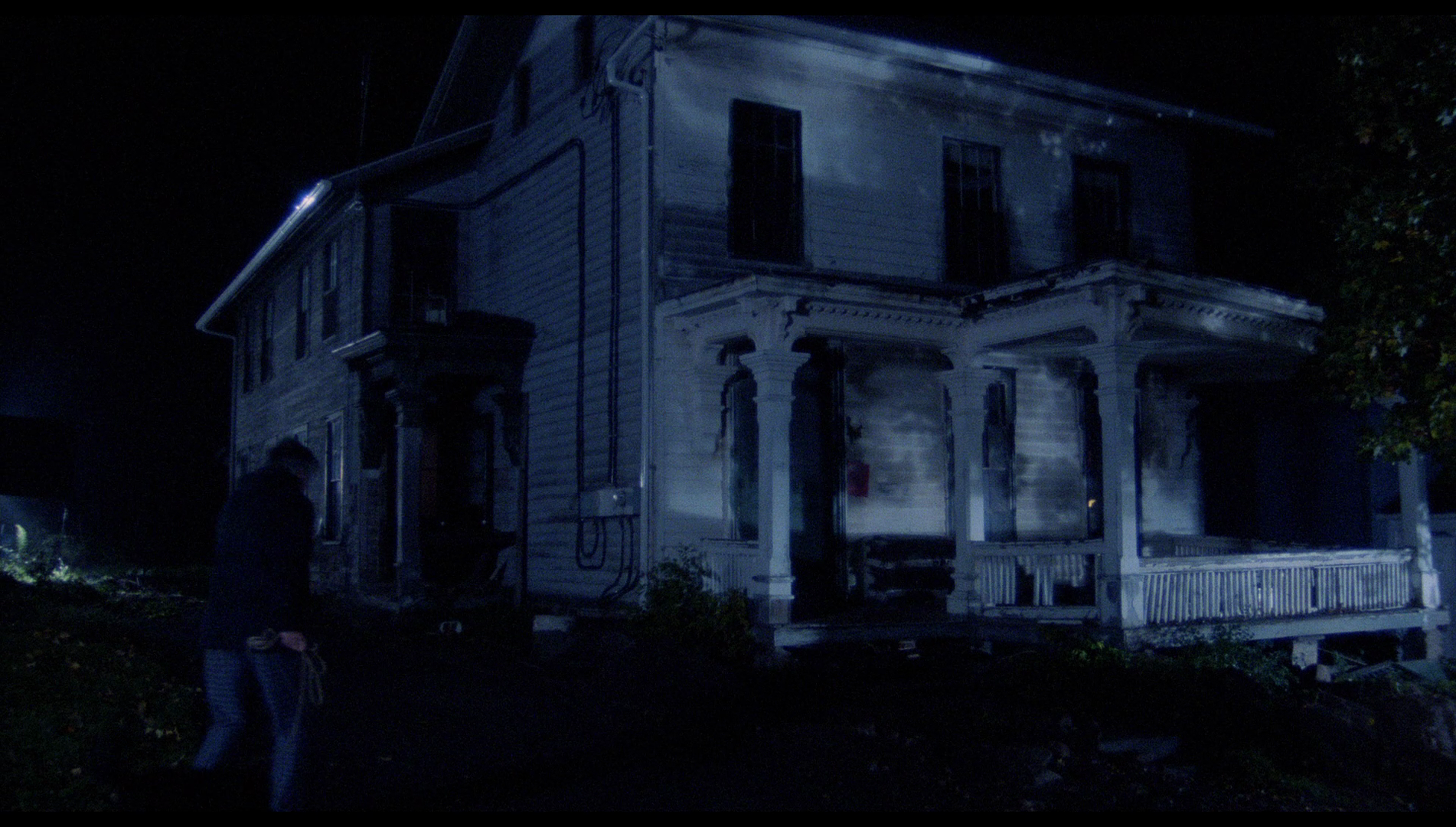 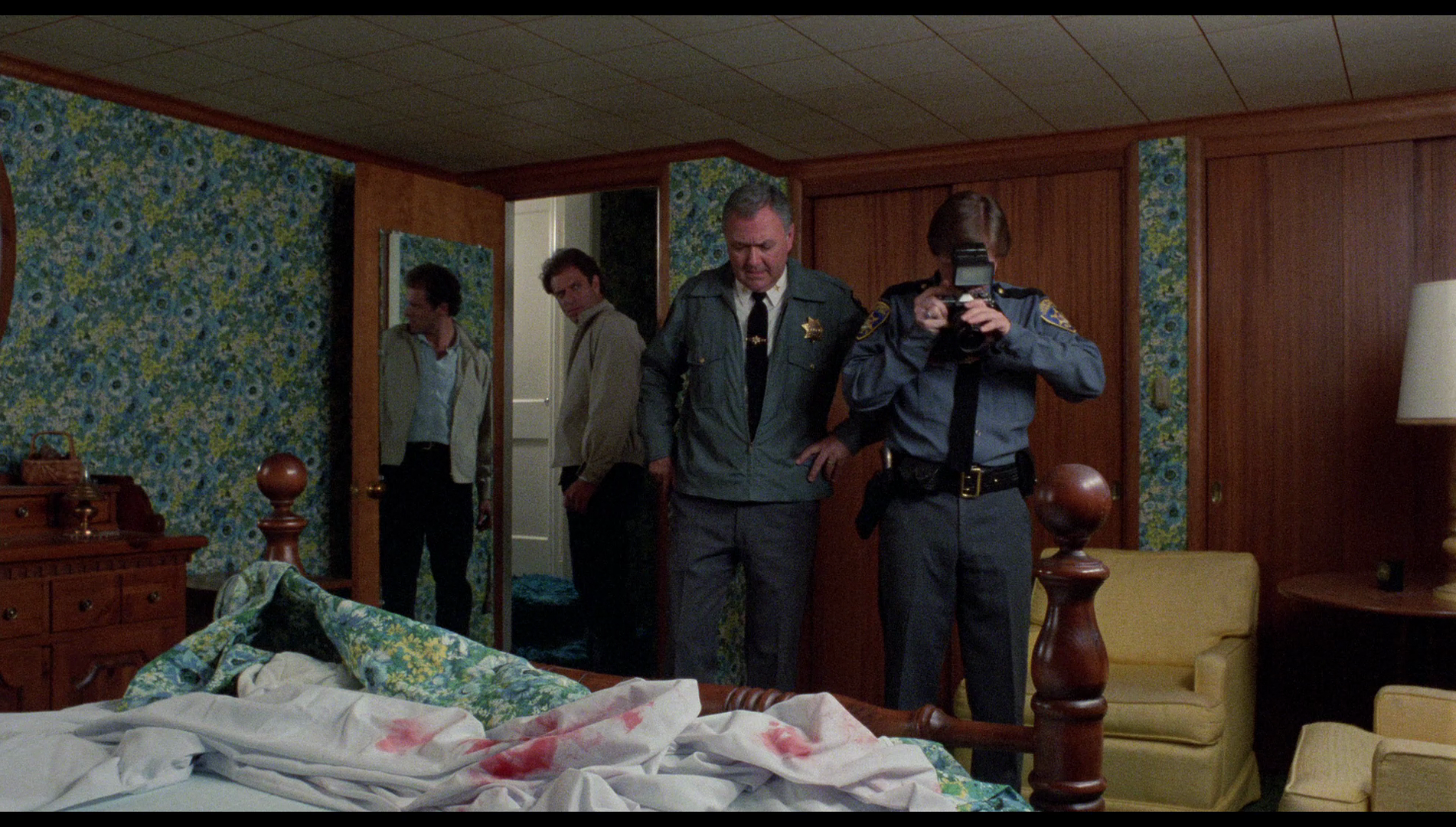
Audio
Audio is presented via a LPCM 1.0 mono track, in English. The dialogue seems to be post-synched. Given the international cast, with American actors working alongside Spanish performers, there may very well have been multiple languages spoken on set. Regardless, the track has excellent range – evident in the shrill, Bernard Herrmann-esque violins used in the main theme. Optional English subtitles for the Hard of Hearing are present on the disc. These are easy to read and free from errors.
Extras
The disc includes:
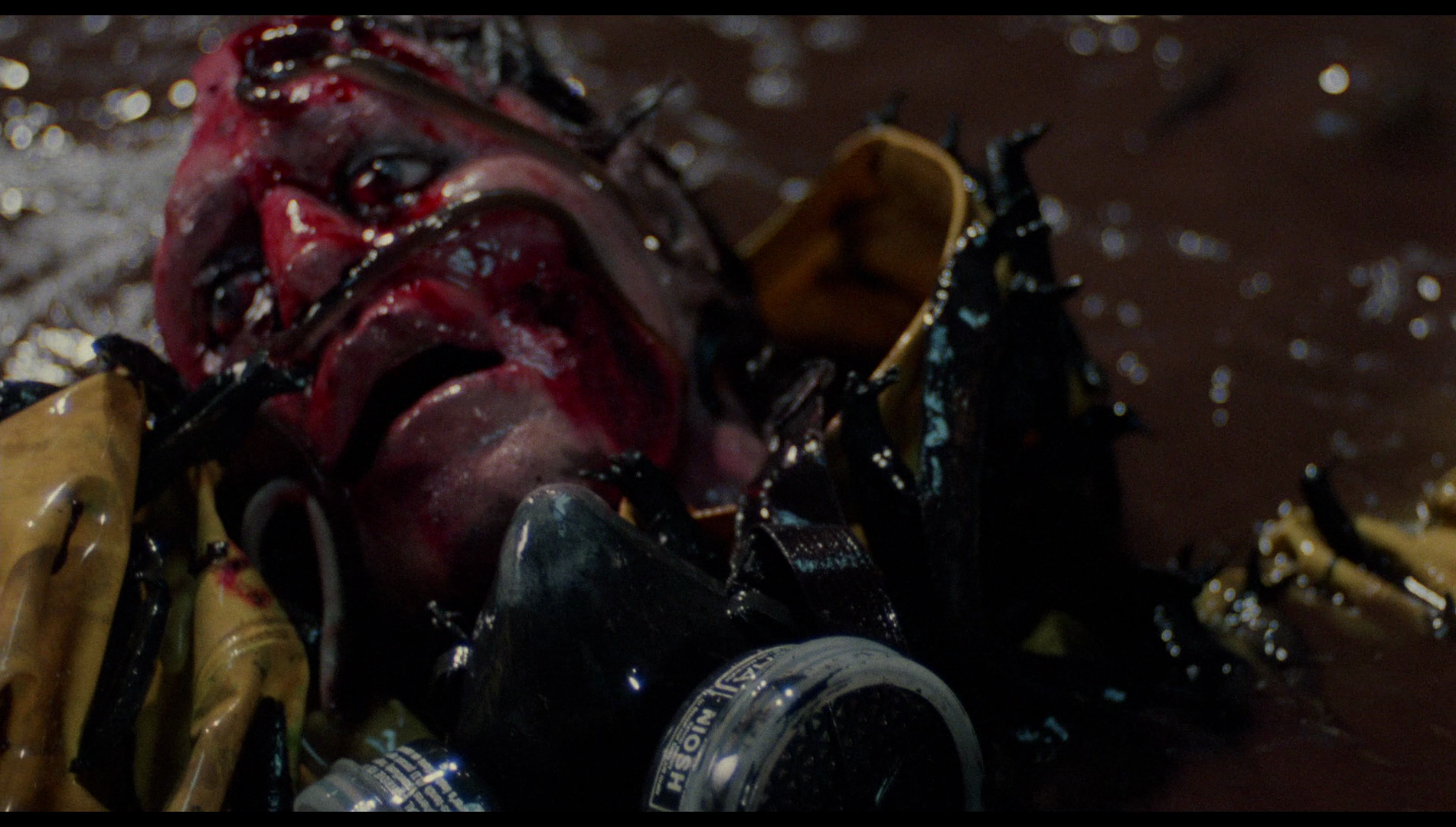 - An audio commentary with Shaun Hutson, moderated by Michael Felsher. Hutson has gone on record as stating that he’s not a great fan of the film, and this commentary is a fascinating feature for fans of Hutson’s work. Hutson talks about his early career and how he came to write Slugs and his attitudes towards the work of other horror authors. He suggests that if a book has a strong sense of pace, this can help overcome some other weaknesses. He also talks about his now long out of print novelisation of The Terminator, which was based on a pre-shooting script. Reflecting on the international cast, Hutson recalls saying at the time of the film’s production ‘it’ll never win anything at Cannes, but it might get an award from the United Nations’. He suggests that if you sell the rights for a novel to a film production company, you should expect that ‘nothing is going to be anything like what you ever created yourself – but you accept that, and the money they pay you sort of compensates for that’. - An audio commentary with Shaun Hutson, moderated by Michael Felsher. Hutson has gone on record as stating that he’s not a great fan of the film, and this commentary is a fascinating feature for fans of Hutson’s work. Hutson talks about his early career and how he came to write Slugs and his attitudes towards the work of other horror authors. He suggests that if a book has a strong sense of pace, this can help overcome some other weaknesses. He also talks about his now long out of print novelisation of The Terminator, which was based on a pre-shooting script. Reflecting on the international cast, Hutson recalls saying at the time of the film’s production ‘it’ll never win anything at Cannes, but it might get an award from the United Nations’. He suggests that if you sell the rights for a novel to a film production company, you should expect that ‘nothing is going to be anything like what you ever created yourself – but you accept that, and the money they pay you sort of compensates for that’.
- An audio commentary with Fangoria editor Chris Alexander. Speaking as a fan of the film, Alexander displays enthusiasm for the picture throughout whilst also communicating a strong sense of irony. This is a light, amusing commentary that is filled with some interesting, often funny, observations about the on-screen action.
- ‘Here’s Slugs in Your Eye’ (7:39). This is a new interview with Emilio Linder, who plays David in the film. Linder reflects on his career generally and his work with J P Simon (the pair made several films together). Linder reveals that the exteriors were shot in New York, whilst the interiors were filmed in Madrid. He reveals that Silvana Mangano, one of his idols, unexpectedly turned up on the set and is featured as an ‘extra’ in the restaurant scene in the film. The interview is in Spanish, with English subtitles.
 - ‘They Slime, They Ooze, They Kill’ (10:46). Here, in another new interview, special effects artist Carlo De Marchis reflects on his work on the film. The interview is interspersed with some remarkable on-set photographs, such as De Marchis standing next to the model which stands in for Harold and Jean’s house during the sequence in which their greenhouse explodes. He discusses in some detail the effects for the sequence in which worms explode from David’s face, and says that during his time working with the great Carlo Rambaldi, he (De Marchis) became confident working with the kinds of molds and paste necessary for such a sequence to be realised. De Marchis suggests that Simon ‘didn’t have a great talent for directing actors’ but was a great director of effects sequences, and he reflects on his joy at winning a Goya award for his effects work for this picture. This interview is also in Spanish, with English subtitles. - ‘They Slime, They Ooze, They Kill’ (10:46). Here, in another new interview, special effects artist Carlo De Marchis reflects on his work on the film. The interview is interspersed with some remarkable on-set photographs, such as De Marchis standing next to the model which stands in for Harold and Jean’s house during the sequence in which their greenhouse explodes. He discusses in some detail the effects for the sequence in which worms explode from David’s face, and says that during his time working with the great Carlo Rambaldi, he (De Marchis) became confident working with the kinds of molds and paste necessary for such a sequence to be realised. De Marchis suggests that Simon ‘didn’t have a great talent for directing actors’ but was a great director of effects sequences, and he reflects on his joy at winning a Goya award for his effects work for this picture. This interview is also in Spanish, with English subtitles.
- ‘Invasion USA’ (11:52). In this interview, the film’s art director Gonzalo Gonzalo discusses his association with Simon. The scenes in America were shot first, and in Spain Simon used his own house to shoot some of the scenes. Gonzalo also talks about some of the logistics involved in shooting the effects scenes. Another new interview, this one is also presented in Spanish with English subtitles.
- ‘The Lyons Den’ (21:00). Larry Ann Evans, the production supervisor for Slugs, is interviewed about her work on the film. She begins the interview in the Wayne County Museum, which Evans is currently in charge of. There, the poster for Slugs is proudly displayed (next to a poster for the only other film shot in Lyons, Frank LaLoggia’s The Lady in White, 1988). Evans discusses how the film adaptation of Hutson’s novel came about, and reflects on the difficulties in using a translator to get the project off the ground. She talks about her admiration for Simon and takes us on a tour of some of the locations used in the film. Yet another new interview, this one is presented in English.
- Trailer (1:37).
Overall
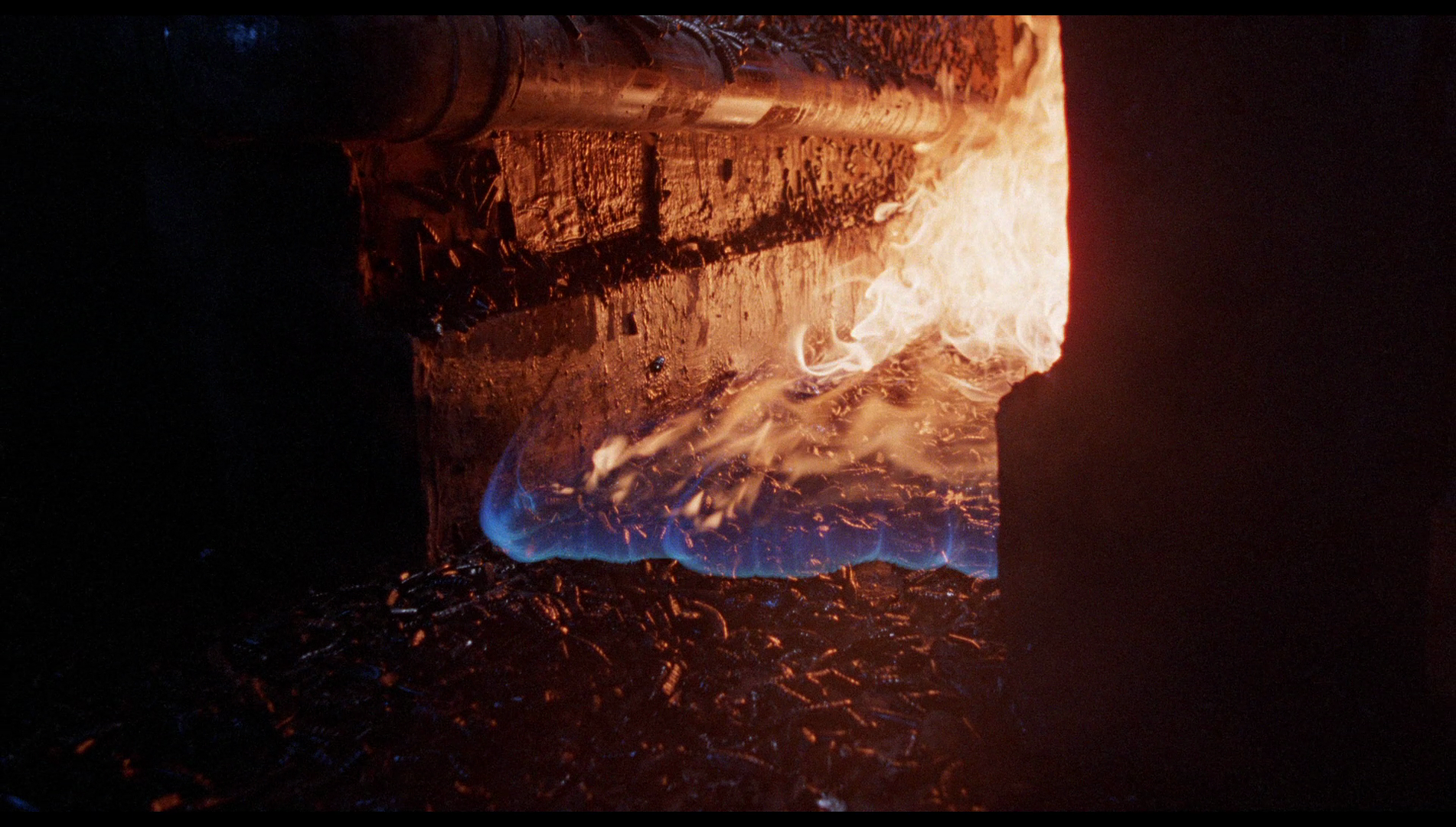 A strange film, this picture has a confused sense of place: clearly intended to take place in small-town America, some of the cast nevertheless speak British English and there’s a very European feel to the whole picture. This is unsurprising, given the film was shot by a Spanish director (Juan Piquer Simon, of Pieces, 1982, fame), features a multinational cast, and is based on a novel by an English writer (Hutson). Hutson’s novel was set in England, in the London Borough of Merton, and though this film adaptation retains much of the narrative content of Hutson’s novel, by translating the plot to America it strips the story of much of its resonance and leaves the picture with a similar, strange mid-Atlantic sensibility to Simon’s Pieces: in Hutson’s novel, Mike is a council health inspector, and in a sly comment about the changing landscape of Britain’s cities, the slugs attack a new housing estate. (It was this very homegrown sense of horror within Hutson’s work that appealed to me, as a child growing up in the UK during the 1980s.) Shifting the action to America turns the story into just another American animal horror picture, with only its gore to differentiate it from the herd. A strange film, this picture has a confused sense of place: clearly intended to take place in small-town America, some of the cast nevertheless speak British English and there’s a very European feel to the whole picture. This is unsurprising, given the film was shot by a Spanish director (Juan Piquer Simon, of Pieces, 1982, fame), features a multinational cast, and is based on a novel by an English writer (Hutson). Hutson’s novel was set in England, in the London Borough of Merton, and though this film adaptation retains much of the narrative content of Hutson’s novel, by translating the plot to America it strips the story of much of its resonance and leaves the picture with a similar, strange mid-Atlantic sensibility to Simon’s Pieces: in Hutson’s novel, Mike is a council health inspector, and in a sly comment about the changing landscape of Britain’s cities, the slugs attack a new housing estate. (It was this very homegrown sense of horror within Hutson’s work that appealed to me, as a child growing up in the UK during the 1980s.) Shifting the action to America turns the story into just another American animal horror picture, with only its gore to differentiate it from the herd.
That said, it’s an entertaining little picture that moves along at a fair old clip, and its enthusiastic gore sequences have earned it a cult following. There are some tremendous scenes (the deaths of Donna and Bobby being perhaps the most memorable, but the sight of the slug biting Mike’s finger is also highly amusing). Arrow’s presentation of the film is very good, and is accompanied by some incredible contextual material: for anyone who has read his work, the commentary from Hutson is a deeply pleasing inclusion, balanced by Alexander’s enthusiastic fan commentary. This is a solid release of a fun picture, and fans of the genre should find plenty to enjoy here.
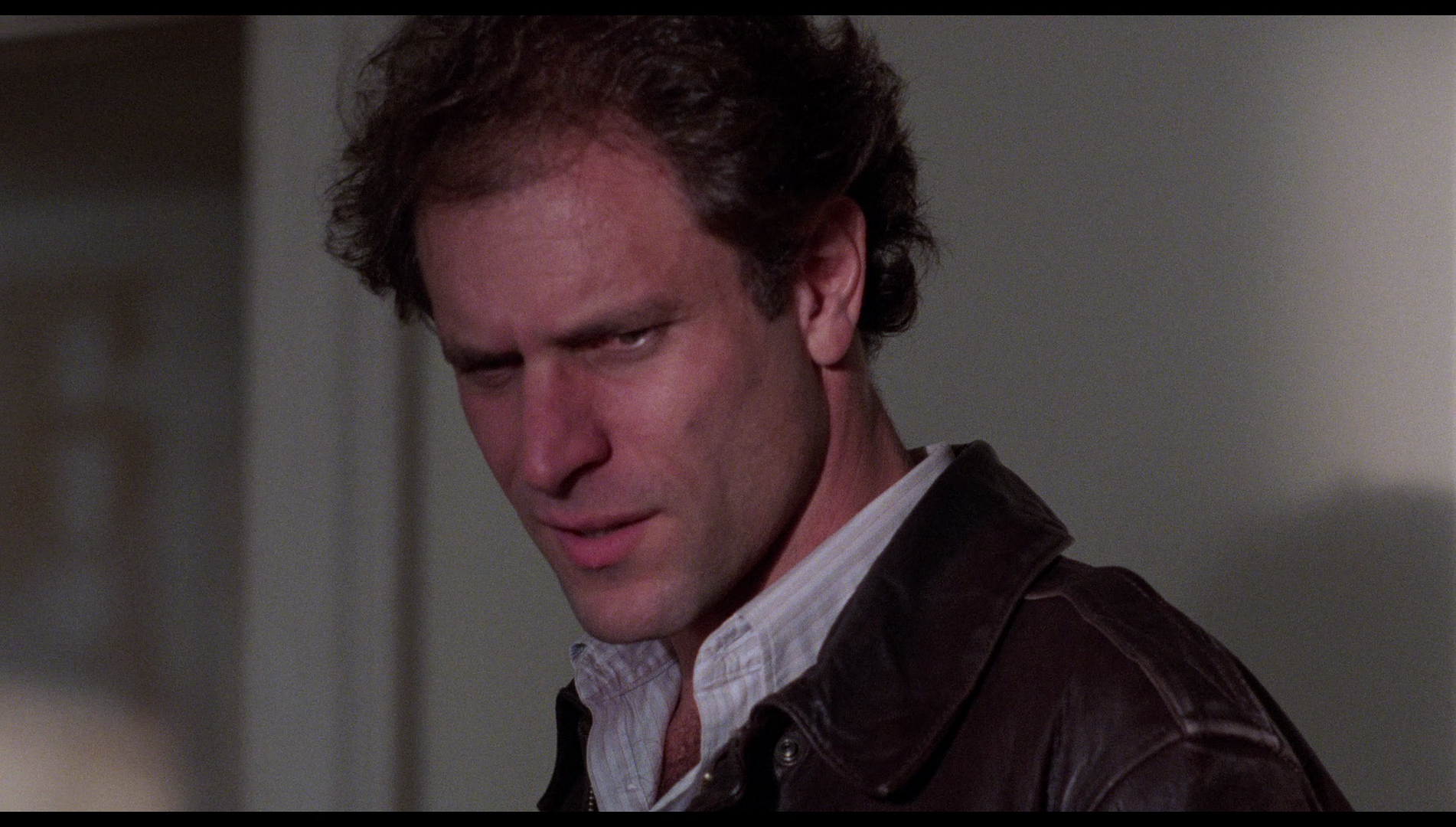

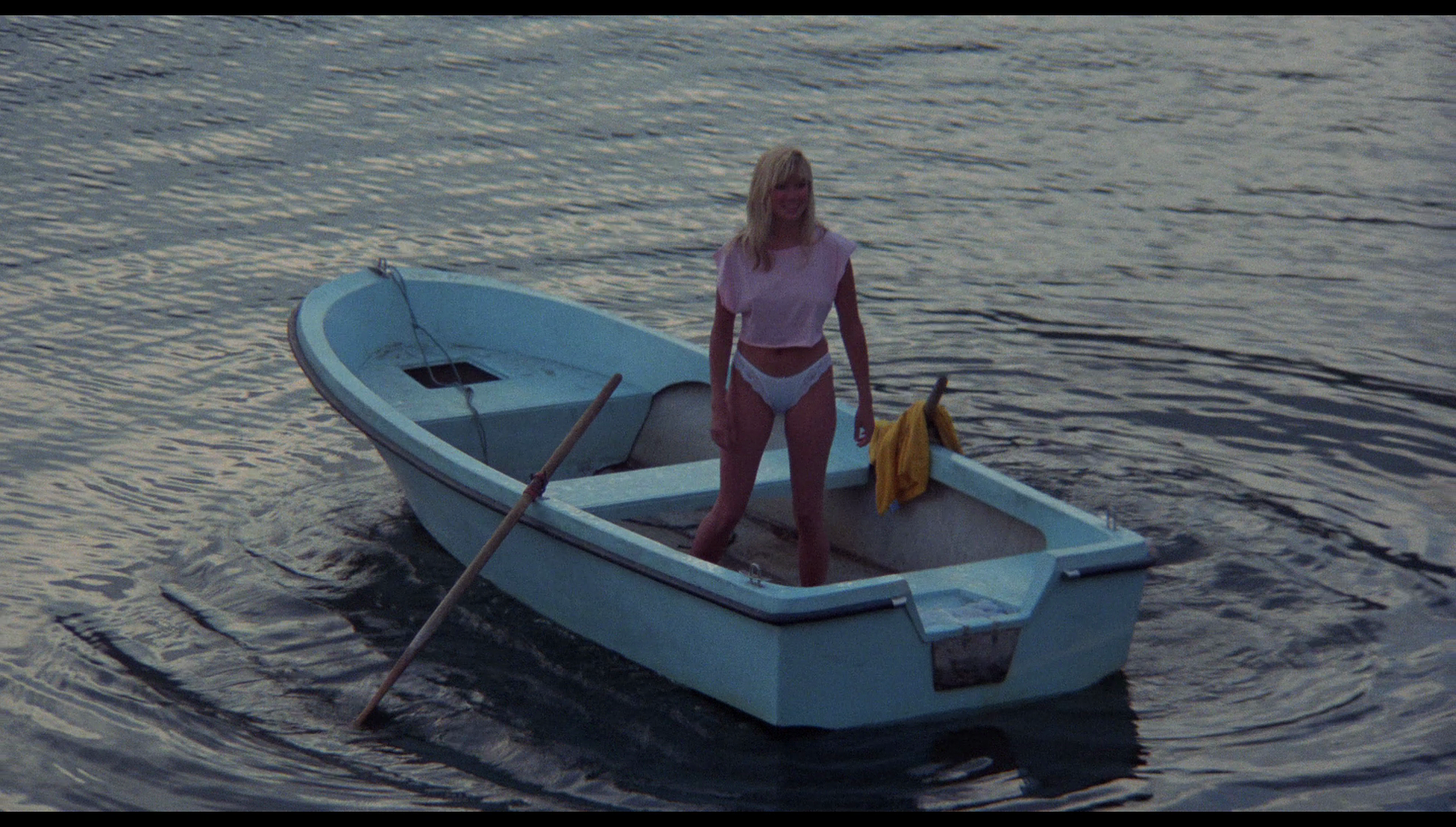
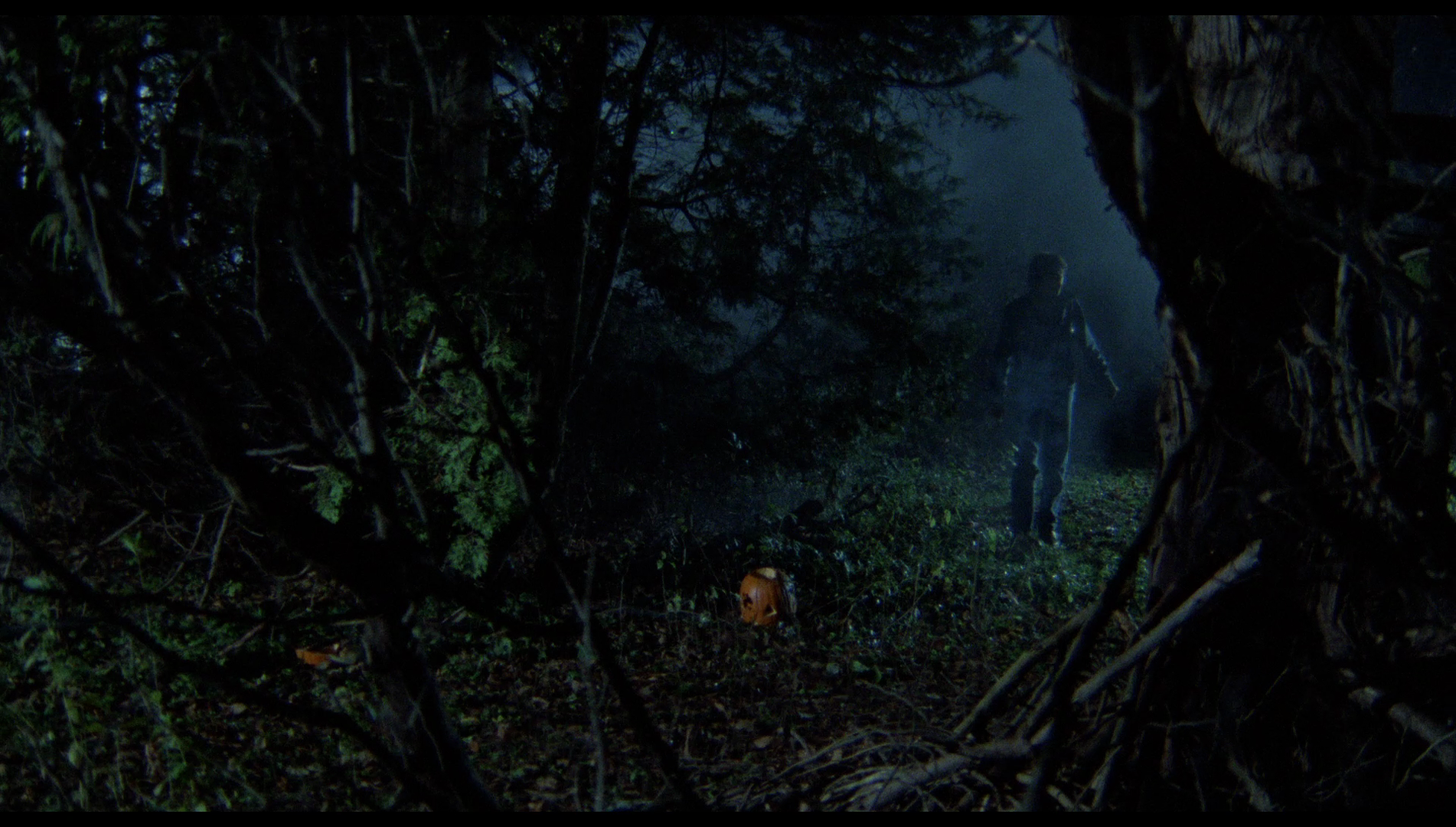
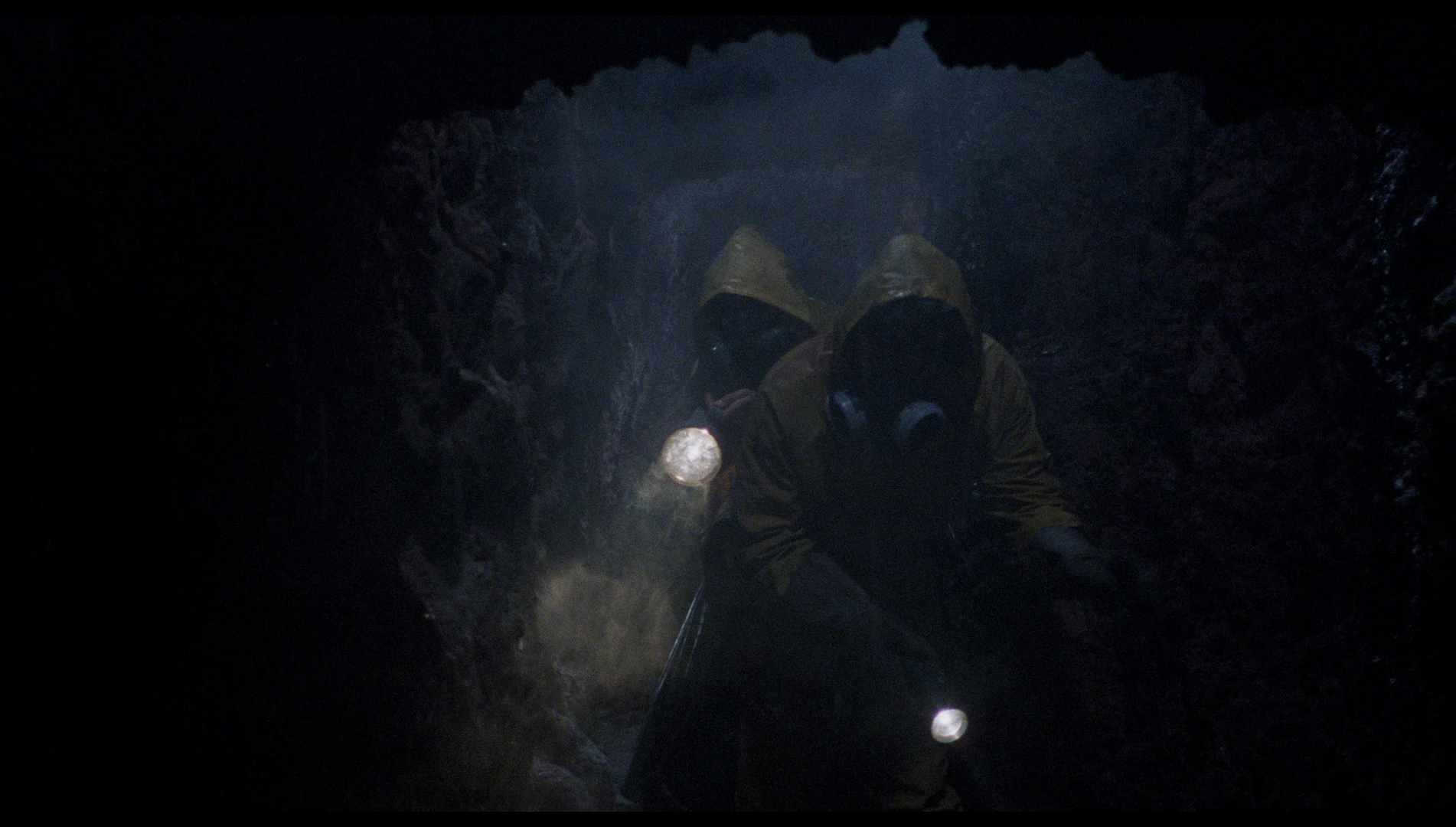


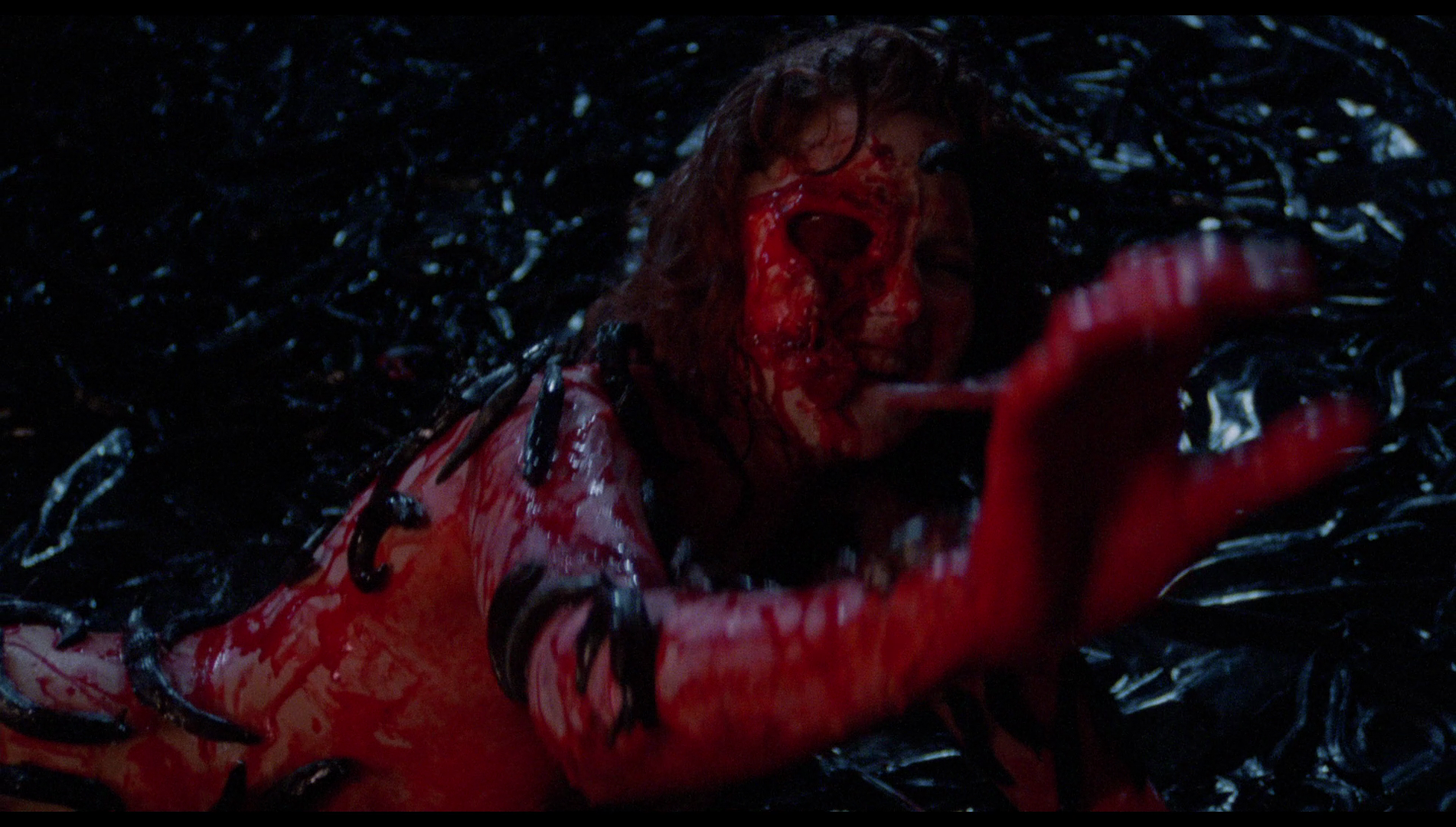
|


